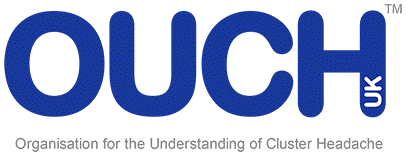OUCH [UK], a support organisation for sufferers of an uncommon headache disorder, have found that their members are experiencing a long wait to be seen in the NHS following referral from primary care to dedicated headache / neurology services.
There are recognised to be severe pressures on neurology services across the UK and while waiting to be seen, NICE and BASH (British Association for the Study of Headache) guidelines do support GP initiation of treatment. Unsurprisingly for an uncommon condition, GPs may lack experience or confidence in prescribing unlicensed medications or frequent licensed acute attack treatments that may be deemed inappropriately to be too costly (albeit recognised by NICE as “cost effective”).
This can lead to severe and potentially unnecessary levels of pain and suffering, Many specialists will consider cluster headache to represent the worst pain known to mankind. A majority of patients will have severe sleep deprivation and potentially very severe consequential mental health effects.
Trustees of OUCH [UK] – (Organisation for the Understanding of Cluster Headache] – are urging their members to take posters to GP surgeries and pharmacies regarding prescribing for the condition Cluster Headache. The charity runs a voluntarily staffed advice line and post-covid the majority of calls regard the long wait to see a headache neurologist for diagnosis and treatment recommendations being sent to the GP.
There are three sources of information/documents that outline prescribing for the condition, and these assist GPs to at least treat the patient pending confirmed diagnosis from a neurologist.
Number 1
is the British National Formulary, known as the BNF, which is the medical
profession’s prescribing bible. The section on Cluster Headache details the drugs sumatriptan [[injections and nasal sprays] verapamil and prednisolone as well as high flow oxygen therapy, and of course referral to a headache neurologist.
Number 2
is the NICE guidelines for prescribing and referral which outlines extremely clear diagnostic criteria and the same treatment suggestions which can be commenced in primary care. The NICE guidelines also comment upon how specialist input and advice may be sought. This means that sufferers can be treated during the long wait to see the consultant neurologist/headache specialist.
Number 3
is the Home Oxygen Order Form which lists cluster headache as an indication for NHS primary care prescription of higher flow short burst oxygen. The completed form is submitted through an online portal and the oxygen is delivered within 24 to 48 hours.
If these prescribing guidelines are followed, then the patient desperate for some relief from their pain can manage better in the wait to see a headache neurologist. The difficulty is that without prescriptions from their GP, sufferers have a long and exceedingly painful wait – eighteen months or more in some cases. If the above prescribing guidelines are followed, then the patient waiting desperately for relief from their pain can manage better until they see a headache neurologist for a confirmed diagnosis and treatment recommendations.
Cluster headache pain strikes at any time and within a few minutes the sufferer can be crying and screaming with pain that can last untreated up to 3 hours or more, and can occur 1 to 6 times a day or more. The nickname for the condition is ‘suicide headache’. Sadly this is no idle nickname. The symptoms are acute pain on one side of the head; reddening and watering of the eye on the same side; blocked or runny nose; droopy eyelid; constricted pupil and extreme restlessness The disease takes two forms.
Episodic – attacks occur for a period of months of weeks and then go away for months at a time, but they will come back – cluster headache is at present a lifelong and incurable condition.
Chronic – attacks occur daily for over a year with painfree period of less than four weeks during that year.
Further information from www.ouchuk.org, info@ouchuk.org, and our Advice Line 0800 669 6824.
Notes to Editors:
OUCH (UK) is a registered charity formed in June 2001
Has 4,000 from all over the world
Largest headache support charity in the world
Has a website and helpline
The charity is run on a voluntary basis and is funded by subscriptions and donations
Holds regular meetings at various venues throughout the UK. The charities aims are:
- provide support for sufferers of Cluster Headaches and their families
- increase public awareness of the condition
- work to improve understanding of the condition, its prevalence and its effects
- liaise with the medical profession to improve diagnosis and treatment
- provide information and access to Cluster Headache sufferers to those engaged in research into the causes, treatments and cure for the condition
- produce its own database based on the experience of sufferers
- maintain a website as a source of information and a contact area for those affected, and produce similar literature for those without internet access




